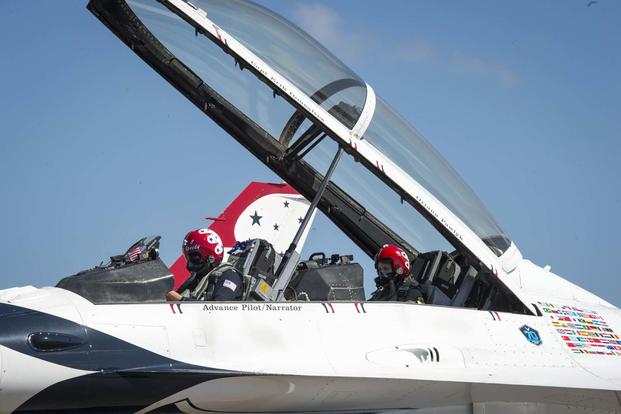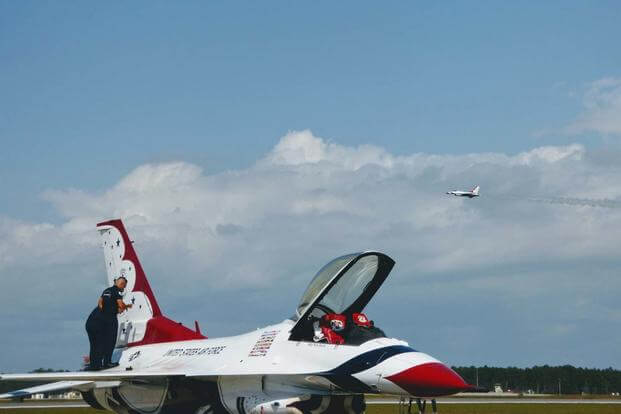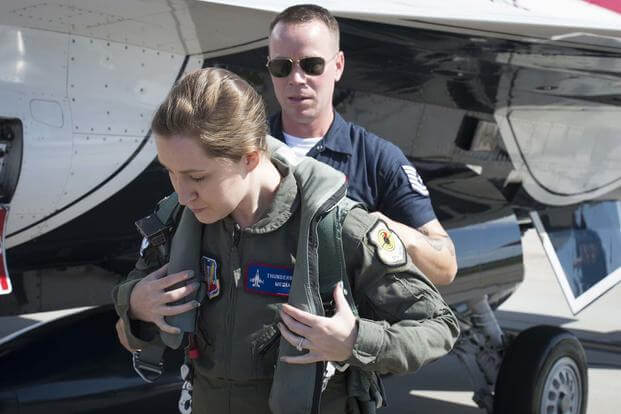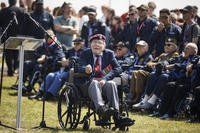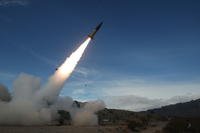TYNDALL AIR FORCE BASE, Florida -- The Air Force Thunderbirds will be flying over the United Kingdom this summer in the traveling demonstration team's first overseas trip since 2011.
The multi-role fighter jets will join Belgian F-16s, England's Eurofighter Typhoons and American F-22 Raptors, among other aircraft, at the Royal International Air Tattoo from July 14 through July 16 at Royal Air Force Fairford.
"This definitely goes along the lines of building partner coalitions," Maj. Nick Krajicek, the slot pilot, flying the No. 4 jet, told Military.com during an interview here at the base.
Military.com caught up with members of the team and even took a ride in an F-16D two-seater on April 21.
Related Video:
Military.com Soars with the Thunderbirds
Krajicek said the Thunderbirds also work with allied teams stateside, too. Earlier this month, the Thunderbirds, part of the 57th Wing at Nellis Air Force Base, Nevada, flew with Patrouille de France demonstration team over Nevada and California.
"The Thunderbirds have a really important mission engaging the public," said Lt. Col. Jason Heard, the commander and leading pilot of the air demonstration team.
RELATED: Will the F-35 Be the Next Thunderbirds Jet?
But as Air Force leaders brace for more budget woes -- lawmakers have been unable to agree on a full-year budget so instead plan to pass a short-term spending measure later this week -- they may once again look to scale back flying hours as a way to cut costs.
"I don't see the Air Force making the decision to cut the Thunderbirds again, I think the mission will continue," Heard said when asked if he was concerned another continuing resolution would cut the team's flight hours or lead to cancellation of shows.
The 2017 and 2018 shows are scheduled, with 38 trips planned for this year and next.
Meanwhile, the service is trying to recruit more pilots to combat a shortfall now estimated at 900 fighter pilots -- an increase of about 200 from a figure cited last summer by top leaders including Chief of Staff Gen. David Goldfein and then-Secretary Deborah Lee James.
It's about "showing them what their military is capable of," said the commander, who prior to joining the Thunderbirds, led an F-15E squadron in combat as an expeditionary squadron commander. Heard has more than 3,000 flight hours under his belt.
Still, the shows aren't guaranteed and anything could happen as a result of budgetary challenges.
"I think the important message here is, yes, combat capability is the most important thing we provide to America," Heard said, referring to the air war against the Islamic State. "If we are forced through these very tough, budgetary decisions to make [cuts], then we will make them," he said.
A 'Drop in the Pond'
The total budget for the team is $36 million, a "drop in the pond of the entire DoD budget," Heard said. And that's for everything -- flying hours, airlift support, travel, uniforms, among other miscellaneous expenses.
The training season for the United States Air Force Air Demonstration Squadron begins in mid-November and lasts through mid-February. The Thunderbirds will fly two to three times a day during training, Heard said. The Federal Aviation Administration and the Air Combat Command commander himself must certify the team as ready and safe to fly before the American public, he said.
The show season lasts from March through November, and the team heads out for a show almost every weekend, returning Mondays, training on Tuesdays, and leaving for the road again on Thursdays.
Half the team rotates every other year, so while new officers are coming in, there's always an officer nearing his or her end of the two-year rotation.
RELATED: F-16 Block 52 Upgrades Set to Take Thunderbirds into the Future
To apply, pilots need a minimum of 750 fighter hours in a fighter airframe, with some positions requiring more experience. This year's pilots collectively have more than 16,100 flight hours in prior service before they joined the team.
During previous years of spending caps known as sequestration, the same team was locked in from the 2012 season into the 2014 season. And that is an option should cuts happen again, Heard said, but it doesn't allow for the pilots to grow their aviation experience.
The 130-person demo team, which harvests 29 different Air Force career fields, has two year rotations for the 12 officers, and three years for the remaining enlisted members. Enlisted airmen have the option of staying on for a fourth year.
About 90 percent of the enlisted side is devoted to maintenance of the jets.
The rotation may seem brief, but for good reason because of the high-stress and demanding travel associated with the assignment, Heard said.
"We kind of function like a wing almost over a squadron," said Capt. Sara Harper, the team's public affairs officer. The Thunderbirds keep all of their maintenance and operations under the same roof.
When they travel, the Thunderbirds gain the help of a C-17 Globemaster III -- sometimes two C-130 Hercules -- to haul 40,000 pounds of equipment.
They also bring a spare F-16 engine with them.
'Planes That Go Into Combat'
Last year, the Thunderbirds had a mishap after an accidental throttle rotation led to a malfunction and subsequent engine stall that led the No. 6 jet to crash. It happened after a flyover at the U.S. Air Force Academy graduation on June 2, of which then-President Barack Obama attended
But the team has since moved on, sounding the alarm for all F-16 squadrons about the malfunction -- which has happened before -- and now requires an extra maintenance check before pilots gear up for flight.
Heard said he doesn't believe the Thunderbirds are the only reason why the Air Force would keep the F-16 in the inventory because as a combat platform it's still better "than most modern fighters being produced by other countries."
Also, the Thunderbirds have a rich, decades-long history dating to 1953. The team has flown various aircraft, including the F-84G Thunderjet, F-100C Super Sabre, F-4E Phantom II and the T-38A Talon.
It's just a matter of time until something eclipses the F-16.
"I don't think the American people want to see their fighter pilots go to war with 40-year-old airplanes either, but we need to very smartly plan for the capability that we require."
Heard added, "But it's important for us to show the American people the same planes that go to combat."
As the service mulls retiring the F-15C/D in favor of replacing its mission with the F-16, Heard said retiring aircraft -- any aircraft -- from the fleet is inevitable. He explained if you remove the F-15 sooner, it won't force a gap in the fighter fleet later.
"Take your risk now instead of taking it later," he said. "If you hold onto it, if you preserve it, and don't bring on a needed capacity for the future, you end up with a hole in your future force structure."
While the decision is coming up fast, right now the Air Force needs everything it can keep its hands on as it brings on the F-35 Joint Strike Fighter, he said.
"We need the air superiority of the F-22 and the F-15C, the multi-role capabilities of the Strike Eagle and the F-16, and we also need the capacity that the current fourth-generation airframes provide," said Heard. "On top of the capability that we require in fifth-generation, which we're trying to move more into.
"It would be great if we had 1,763 F-35s on the [flight]line right now, and it would be great to [move from] 55 fighter squadrons to 60 -- but we don't. So what we're going to have to do is manage an aging fleet for a long time, and we will limp this fleet into the future with [Service Life Extension Programs] and upgrades until we can bring on the capability that we really require."
-- Oriana Pawlyk can be reached at oriana.pawlyk@military.com. Follow her on Twitter at @Oriana0214.
